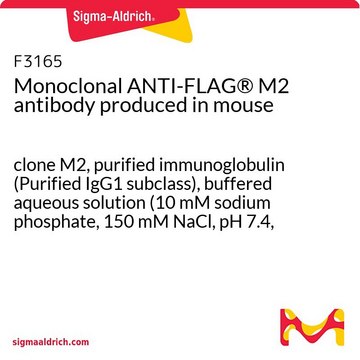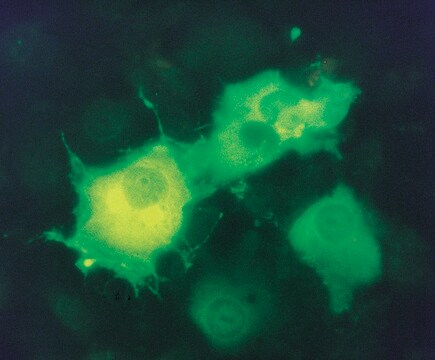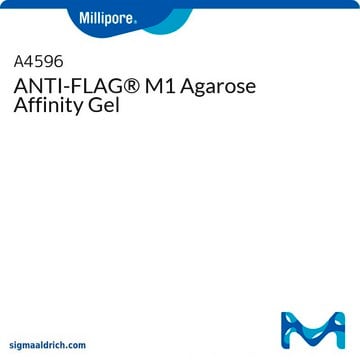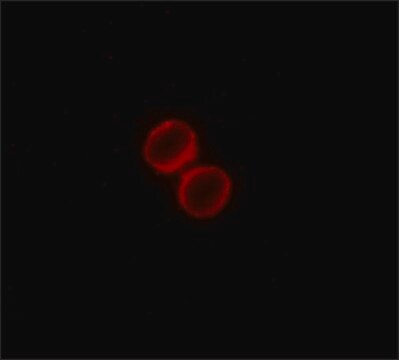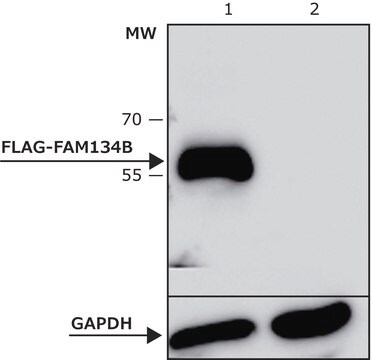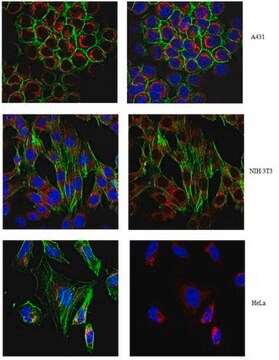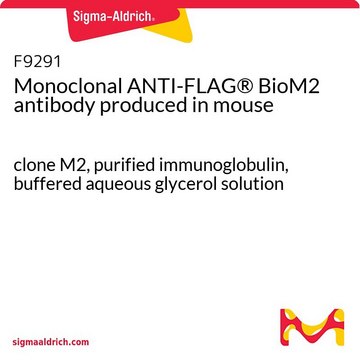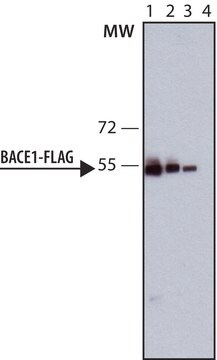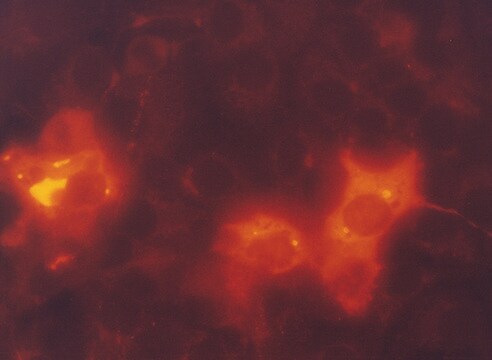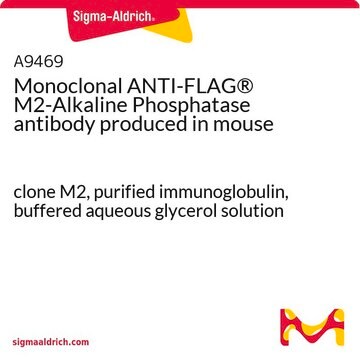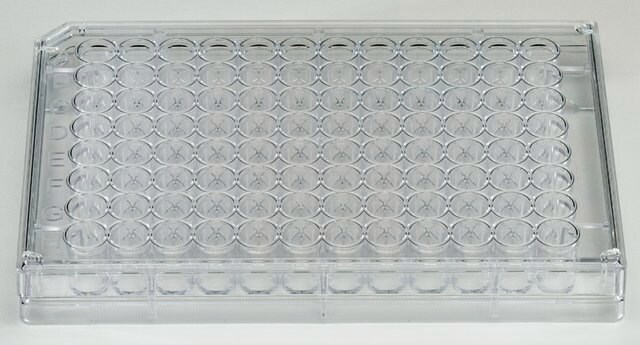추천 제품
생물학적 소스
mouse
Quality Level
항체 형태
ascites fluid
항체 생산 유형
primary antibodies
클론
2EL-1B11, monoclonal
종 반응성
vertebrates, E. coli
종 반응성(상동성에 의해 예측)
rat
제조업체/상표
Chemicon®
기술
ELISA: suitable
immunocytochemistry: suitable
immunofluorescence: suitable
immunoprecipitation (IP): suitable
western blot: suitable
동형
IgG1
배송 상태
dry ice
타겟 번역 후 변형
unmodified
일반 설명
Epitope tags provide a method to localize gene products in a variety of cell types, study the topology of proteins and protein complexes, identify associated proteins, and characterize newly identified, low abundance or poorly immunogenic proteins when protein specific antibodies are not available. Tagging with xxxDDDDK may be done at the N-terminus, N-terminus preceded by a methionine residue, C-terminus, and in internal positions of the target protein. The small size of the epitope tag and its high hydrophilicity tend to decrease the possibility of interference with protein expression, proteolytic maturation, antigenicity and function. The enterokinase cleavage site allows it to be completely removed from the purified fusion proteins.
FLAG® is a registered trademark of Sigma-Aldrich Biotechnology LP and Sigma-Aldrich Co.
FLAG® is a registered trademark of Sigma-Aldrich Biotechnology LP and Sigma-Aldrich Co.
특이성
DYKDDDDK sequence containing proteins. Reacts with both N-terminal and C-terminal fusion proteins.
면역원
Epitope: Epitope tag
Synthetic peptide M-Asp-Tyr-Lys-Asp-Asp-Asp-Asp-Lys(C) coupled to ovalbumin
애플리케이션
Detect DYKDDDDK (FLAGepitope tag) using this Anti-DYKDDDDK (FLAG epitope tag) Antibody, clone 2EL-1B11 validated for use in ELISA, IC, IF, IP & WB.
Immunofluorescence:
A 1:1,000-1:5,000 dilution of a previous lot was used in IF.
Immunoprecipitation:
A 1:1,000-1:5,000 dilution of a previous lot was used IP on recombinant proteins.
ELISA:
A 1:1,000-1:5,000 dilution of a previous lot was used in Enzyme-linked immunosorbent assay on recombinant proteins.
Note: Does not require Ca++ for binding.
Immunoblotting:
on recombinant proteins
Optimal working dilutions must be determined by the end user.
A 1:1,000-1:5,000 dilution of a previous lot was used in IF.
Immunoprecipitation:
A 1:1,000-1:5,000 dilution of a previous lot was used IP on recombinant proteins.
ELISA:
A 1:1,000-1:5,000 dilution of a previous lot was used in Enzyme-linked immunosorbent assay on recombinant proteins.
Note: Does not require Ca++ for binding.
Immunoblotting:
on recombinant proteins
Optimal working dilutions must be determined by the end user.
Research Category
Epitope Tags & General Use
Epitope Tags & General Use
Research Sub Category
Epitope Tags
Epitope Tags
품질
Routinely evaluated by Western Blot on Flag-mTor protein blot.
Western Blot Analysis:
1:500 dilution of this lot detected Flag mTor on Flag-mTOR blot.
Western Blot Analysis:
1:500 dilution of this lot detected Flag mTor on Flag-mTOR blot.
결합
Replaces: AB3250
물리적 형태
Ascites mouse monoclonal IgG1 liquid containing no preservative.
Unpurified
저장 및 안정성
Stable for 1 year at -20°C in undiluted aliquots from date of receipt.
Handling Recommendations: Upon receipt, and prior to removing the cap, centrifuge the vial and gently mix the solution. Aliquot into microcentrifuge tubes and store at -20°C. Avoid repeated freeze/thaw cycles, which may damage IgG and affect product performance.
Handling Recommendations: Upon receipt, and prior to removing the cap, centrifuge the vial and gently mix the solution. Aliquot into microcentrifuge tubes and store at -20°C. Avoid repeated freeze/thaw cycles, which may damage IgG and affect product performance.
분석 메모
Control
Cells transfected with FLAG-tagged fusion vector
Cells transfected with FLAG-tagged fusion vector
기타 정보
Concentration: Please refer to the Certificate of Analysis for the lot-specific concentration.
법적 정보
CHEMICON is a registered trademark of Merck KGaA, Darmstadt, Germany
FLAG is a registered trademark of Merck KGaA, Darmstadt, Germany
면책조항
Unless otherwise stated in our catalog or other company documentation accompanying the product(s), our products are intended for research use only and are not to be used for any other purpose, which includes but is not limited to, unauthorized commercial uses, in vitro diagnostic uses, ex vivo or in vivo therapeutic uses or any type of consumption or application to humans or animals.
적합한 제품을 찾을 수 없으신가요?
당사의 제품 선택기 도구.을(를) 시도해 보세요.
Storage Class Code
10 - Combustible liquids
WGK
WGK 1
Flash Point (°F)
Not applicable
Flash Point (°C)
Not applicable
시험 성적서(COA)
제품의 로트/배치 번호를 입력하여 시험 성적서(COA)을 검색하십시오. 로트 및 배치 번호는 제품 라벨에 있는 ‘로트’ 또는 ‘배치’라는 용어 뒤에서 찾을 수 있습니다.
이미 열람한 고객
Juan Liu et al.
Autophagy, 17(8), 1962-1977 (2020-08-05)
Iron metabolism is involved in numerous physiological processes such as erythropoiesis, oxidative metabolism. However, the in vivo physiological functions of the iron metabolism-related gene Hfe in immune response during viral infection remain poorly understood. Here, we identified 5 iron metabolism-associated
Jacqueline C Simonet et al.
Biology open, 9(7) (2020-06-26)
Polymerization of metabolic enzymes into micron-scale assemblies is an emerging mechanism for regulating their activity. CTP synthase (CTPS) is an essential enzyme in the biosynthesis of the nucleotide CTP and undergoes regulated and reversible assembly into large filamentous structures in
Jemila C Kester et al.
Journal of bacteriology, 203(4) (2020-11-25)
The ClpP1P2 proteolytic complex is essential in Mycobacterium tuberculosis Proteolysis by ClpP1P2 requires an associated ATPase, either ClpX or ClpC1. Here, we sought to define the unique contributions of the ClpX ATPase to mycobacterial growth. We formally demonstrated that ClpX
Lushen Li et al.
Journal of cell science, 130(8), 1475-1485 (2017-03-08)
Surface expression of chemokine receptor CXCR4 is downregulated by missing-in-metastasis protein (MIM; also known as MTSS1), a member of the inverse BAR (I-BAR)-domain protein family that recognizes and generates membranes with negative curvature. Yet, the mechanism for the regulation is
Samer Swedan et al.
Journal of virology, 85(19), 10090-10100 (2011-07-29)
Human respiratory syncytial virus (RSV), a major cause of severe respiratory diseases, efficiently suppresses cellular innate immunity, represented by type I interferon (IFN), using its two unique nonstructural proteins, NS1 and NS2. In a search for their mechanism, NS1 was
자사의 과학자팀은 생명 과학, 재료 과학, 화학 합성, 크로마토그래피, 분석 및 기타 많은 영역을 포함한 모든 과학 분야에 경험이 있습니다..
고객지원팀으로 연락바랍니다.